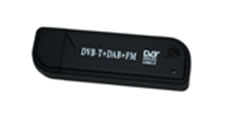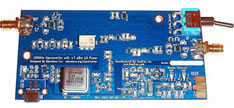SDR Radio using DVB-T USB Dongle (RTL-SDR)


A low cost USB dongle can become a surprisingly competent receiver for all listening applications from HF to UHF.
The DVB-T USB dongle that you can pick up from outlets like amazon.com at ~$20 (search for SDR RADIO) can be used as the front end for the SDR radio applications. There are two popular, ready-to-run public domain software available. One is called SDR# (pronounced SDR sharp), which is a good general purpose, capable of AM, SSB, CW, FM reception, but (IMHO) more useful for broadcast receiving. The other, HDSDR, works more like your HF communications receiver. Both software feature a wide spectrum display and waterfall chart, so you can monitor the whole band at any given instance. They also have built-in width adjustable filters and very effective notch filters.
The QST article on January 2013 issue has the detailed instruction on how to start this easy and low cost but effective SDR project. Below is a simplified instruction in case you do not have access to the QST issue.
DVB-T USB dongle is a simple tuner / decoder for European over-the-air digital TV receiver, and though they vary from unit to unit, they are typically capable of receiving 60MHz to 2GHz range. It has the mode where it can put out 8-bit quadrature audio to be fed to your PC sound card, for the SDR applications. As it is however, it cannot be used to receive HF frequency range.
Fortunately, there are a few up-converters such as NooElec www.nooelec.com . This one costs about $38, and is a newer version than I’ve had originally. This board has a 125MHz local oscillator and a mixer on board, converting 3-60MHz signal to 128-185MHz (The original v1.0 board I have had 100MHz LO, but they had to change it as it suffered an interference from US broadcasting band). It has reasonable filters at input and output to suppress unwanted signals and images, and it works surprisingly well. The up-converter output is fed to the antenna input of the dongle. The performance of the receiver system relies heavily on a good external antenna, just like any other radios we use. If a little antenna came with the dongle, ignore it – it’s practically useless.
There are now several other hardware available. Check “Web Resources on RTL-SDR Upconverters” at the end of this paper.
It should be noted that DVB-T dongle usually has MCX connector for its antenna input (check when you buy) which is fairly unusual in US. Amazon does sell a coax cable with the connector, with SMA on the other end, which NooElec up converter board requires. Make sure you get a proper cable.
[Author’s Note] Be careful, many of those “odd cable adaptors” come from China, which means it can take a couple of weeks to get here. The MCX adaptor cable I bought also had flimsy contacts where the surface foil wore out quickly. I ended up soldering the cable directly to inside of the DVB adaptor.
I also had to get me a SMA to UHF female adapter (HRO has it), to hook up my HF antenna to the converter. The converter is powered by 5V through micro USB connector. If you have a smart phone or certain pad devices, you probably have that cable already. Otherwise, get a proper USB cable also. They can be had for fairly low cost (but be careful, if you order them through amazon, they tend to come from separate vendors and the freight charges add up quickly).
Update: the surface mount micro-B connector is pretty fragile. I had mine ripped out shortly after I did the last update. The version 1.2 of the NooElec board allegedly has more robust connector, but I do not know. I ultimately attached a power cable to the PCB directly and used cable tie for stress relief. The strength of such arrangement is still questionable, but so far holding up better than the original micro-B.